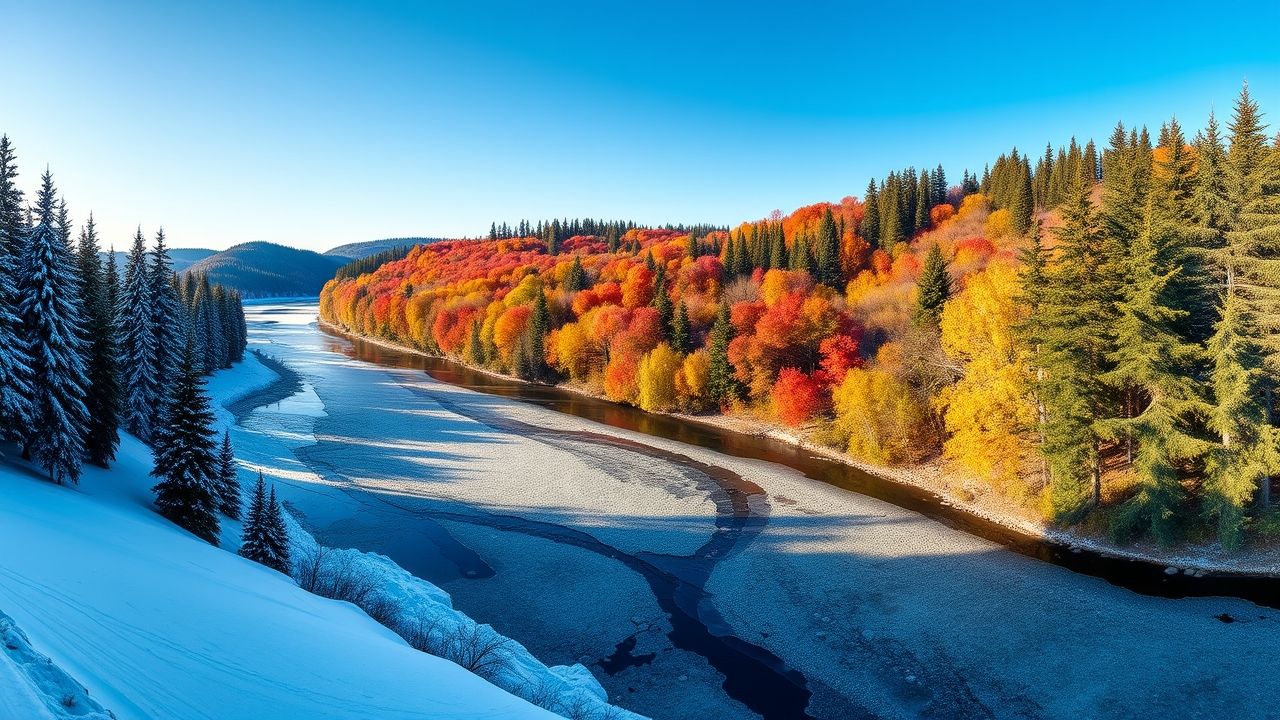Edmonton Weather: A Local’s Guide to Four Distinct Seasons
Ah, Edmonton weather! It’s the topic of endless conversation, the bane and beauty of our daily lives here in Alberta’s capital. Often described as a city of extremes, Edmonton truly embodies the spirit of four distinct seasons, each bringing its own challenges and charms. From the crisp, sun-drenched days of summer to the undeniably bracing cold of winter, understanding our local climate is key to truly appreciating this northern metropolis. For those new to the city, or even long-time residents just seeking to make sense of the latest forecast, a deep dive into Edmonton’s meteorological personality is in order.
Key Summary
- Edmonton experiences a
continental climate with significant temperature variations between seasons. - Winters are typically
cold and dry with substantial snowfall, but often include bright, sunny days. - Summers are
warm and often humid , known for long daylight hours and occasional severe thunderstorms. - Spring and Autumn offer
transitional periods with unpredictable temperatures and beautiful natural changes. - Chinook winds can bring
sudden temperature shifts , especially in winter.
Why This Story Matters: Life Under Edmonton’s Sky
The rhythm of life in Edmonton is inextricably linked to its weather. From daily commutes to the planning of major festivals, the climate dictates much of our activity. Businesses adapt to seasonal demands, outdoor recreation shifts dramatically with the mercury, and even our local fashion choices are a direct response to what the sky delivers. Understanding the nuances of Edmonton weather isn’t just about dressing appropriately; it’s about appreciating the resilience and adaptability of our community. It shapes our architecture, influences our energy consumption, and defines our outdoor spaces. When the temperature plummets, community leagues become bustling hubs of indoor activity, and when summer arrives, our river valley transforms into a vibrant playground. This dynamic relationship between the city and its climate makes our weather not just a forecast, but a fundamental part of our identity.
Understanding Edmonton’s Unique Weather Patterns
Edmonton sits on the edge of the Canadian prairies, experiencing a humid continental climate that makes for pronounced seasonal shifts. Our northerly latitude means incredibly long summer days and short winter ones, amplifying the feeling of each season.
Winter’s Grip: Surviving the Cold
When most people think of Edmonton, they often think of its winters. And yes, they can be cold. Temperatures regularly drop below -20°C, and occasionally dip into the -30s or even -40s with wind chill. However, what often goes unmentioned is the stunning beauty of an Edmonton winter. The sky is often a brilliant, crisp blue, and the fresh snow sparkles under the sun. We typically receive a good amount of snow, making for picturesque landscapes and opportunities for winter sports like skiing and skating. While the cold demands proper layering and a block heater for your car, the city embraces it with numerous winter festivals and activities. It’s a season of quiet beauty and robust outdoor resilience.
Summer’s Embrace: Storms and Sunshine
After the long winter, Edmontonians eagerly anticipate summer, and it rarely disappoints. Our summers are glorious, with average daytime temperatures often hovering around 23°C and frequently climbing into the high 20s or even low 30s. The long daylight hours—often extending past 10 PM in June and July—make for extended evenings perfect for patio dining, river valley walks, and community events. However, summer also brings the potential for dramatic weather events. Thunderstorms, sometimes severe with heavy rain, hail, and strong winds, are a common feature of our warmer months. These can develop rapidly, turning a sunny afternoon into a tumultuous downpour within minutes, reminding us of nature’s power even in fair seasons.
Spring Thaw and Autumn Hues
Spring in Edmonton is a period of transition, often characterized by rapid temperature swings as winter loosens its grip. One day can feel like a winter reprieve, the next like a true sign of spring. Melting snow, budding trees, and returning migratory birds mark this season. Autumn, by contrast, is often considered one of our most beautiful seasons. The changing leaves turn the river valley into a riot of gold, orange, and red. Temperatures are generally mild and pleasant, though cooler nights signal the impending return of winter. Both spring and autumn serve as vital bridges, preparing us for the next climatic chapter.
Expert Analysis / Insider Perspectives
Reporting from the heart of the community, I’ve seen firsthand how interconnected our city’s mood and activities are with the prevailing weather conditions. On particularly cold winter days, the warmth of local coffee shops and community centres becomes more palpable, acting as essential gathering points. Conversely, the first truly warm day of spring sends everyone outdoors, filling parks and patios almost instantly. This immediate shift is something you truly feel when you live here.
“Edmontonians are resilient. We don’t just endure the weather; we learn to live with it, adapt to it, and often, even celebrate it. Our relationship with the climate is a defining characteristic of our local culture.”
— A Long-Time Edmonton Resident
In my 12 years living in this city, I’ve found that while outsiders often focus on the extremes, it’s the subtle shifts and the unique microclimates within different neighbourhoods that truly intrigue. How the river valley creates its own fog, or how a particular street captures the afternoon sun just right. These are the details that locals notice and appreciate, fostering a deeper connection to our environment.
Common Misconceptions About Edmonton Weather
One prevalent misconception is that Edmonton is perpetually buried under snow or constantly experiencing frigid temperatures. While winters are cold, they are also often sunny and dry, leading to less slush than in more humid climates. Another misunderstanding is the lack of extreme heat; while our summers are shorter than those further south, they can be intensely hot and humid for periods, punctuated by those intense thunderstorms. The city also experiences “Chinook” winds, particularly in the western parts, which can cause sudden, dramatic temperature rises in winter, melting snow quickly and offering a temporary reprieve from the cold—a truly unique aspect of our regional weather edmonton. These rapid thaws often surprise visitors but are a cherished part of the winter experience for locals.
Navigating Life with Edmonton Weather
Living successfully in Edmonton means embracing all four seasons. For winter, investing in quality layering clothing, insulated boots, and a warm hat is essential. Understanding the importance of block heaters for vehicles is also crucial. In summer, staying hydrated, using sunscreen, and being aware of thunderstorm warnings become priorities. Locals have developed a rhythm for dealing with these shifts: winter drives mean leaving extra time; summer evenings mean enjoying outdoor dining as late as possible. Our strong public transportation system and extensive network of indoor facilities, like the pedway system downtown, also help mitigate the challenges of more extreme conditions. Ultimately, it’s about preparedness and enjoying the unique character each season brings.
Frequently Asked Questions
Q: How cold does Edmonton get in winter?
A: Winter temperatures in Edmonton commonly drop below -20°C, with extremes sometimes reaching -30°C to -40°C, especially with wind chill. However, many winter days are sunny and closer to -10°C.
Q: Does Edmonton get a lot of snow?
A: Yes, Edmonton receives significant snowfall, averaging around 120-140 cm annually, providing ample opportunities for winter activities but also requiring consistent snow removal efforts.
Q: What are summers like in Edmonton?
A: Summers are warm and pleasant, with average daytime temperatures around 23°C, frequently reaching the high 20s or low 30s. They are also characterized by long daylight hours and occasional intense thunderstorms.
Q: What is a “Chinook” wind?
A: A Chinook is a warm, dry wind that blows down the leeward side of the Rocky Mountains, causing rapid temperature increases in winter. While more common in Calgary, Edmonton can experience milder Chinook effects, bringing temporary thaws.
Q: Is Edmonton’s weather unpredictable?
A: Due to its continental climate and proximity to the Rockies, Edmonton’s weather can be quite variable, especially during transitional seasons like spring and autumn, with rapid changes in temperature and conditions.


